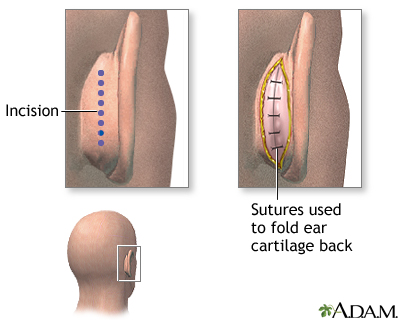
Overview
Thousands of ear surgeries (otoplasties) are performed successfully each year. The surgery may be done in the surgeon's office-based facility, in an outpatient surgical facility, or in a hospital. The surgery is performed while the patient is awake but pain free (local anesthetic) or deep asleep and pain free (general anesthetic). The procedure usually lasts about two hours, depending on the extent of the correction needed.
The most commonly employed technique is one in which the surgeon makes incisions in the back of the ear and removes skin to expose the ear cartilage. Sutures are used to fold the cartilage to reshape the ear.
Other surgeons choose to forgo sutures in favor of cutting or abrading the cartilage before folding it.
The ear is brought closer to the head by creating a more pronounced fold (called the antihelix) in the central portion of the ear.
Review Date 12/10/2021
Updated by: Tang Ho, MD, Associate Professor, Division of Facial Plastic and Reconstructive Surgery, Department of Otolaryngology – Head and Neck Surgery, The University of Texas Medical School at Houston, Houston, TX. Also reviewed by David Zieve, MD, MHA, Medical Director, Brenda Conaway, Editorial Director, and the A.D.A.M. Editorial team.


